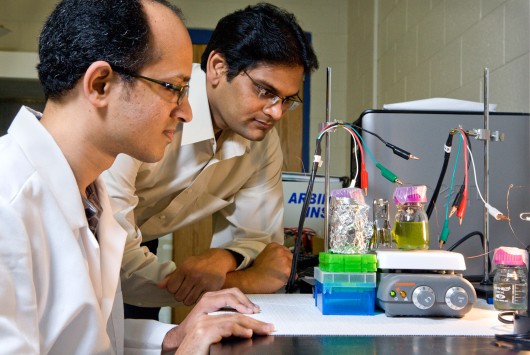Via gizmag
-----
Millions of years of evolution has resulted in plants being the most
efficient harvesters of solar energy on the planet. Much research is
underway into ways to artificially mimic photosynthesis in devices like artificial leaves,
but researchers at the University of Georgia (UGA) are working on a
different approach that gives new meaning to the term “power plant.”
Their technology harvests energy generated through photosynthesis before
the plants can make use of it, allowing the energy to instead be used
to run low-powered electrical devices.
Photosynthesis turns light energy into chemical energy by splitting
water atoms into hydrogen and oxygen. This process produces electrons
that help create sugars that the plant uses to fuel growth and
reproduction. A team led by Ramaraja Ramasamy, assistant professor in
the UGA College of Engineering, is developing technology that would
interrupt the photosynthesis process and capture the electrons before
the plant puts them to use creating sugars.
The technology involves interrupting the pathways along which the
electrons flow by manipulating the proteins contained in thylakoids.
Thylakoids are membrane-bound compartments at the site of the light
reactions of photosynthesis that are responsible for capturing and
storing energy from sunlight.
The modified thylakoids are immobilized on a specially designed
backing of carbon nanotubes that acts as an electrical conductor to
capture the electrons and send them along a wire. The researchers say
that small-scale experiments of this system have yielded a maximum
current density that is two orders of magnitude larger than previously
reported for similar systems.
While you won’t be running your HDTV off the nearest tree anytime
soon, Ramasamy says the technology has the potential to find its way
into less power-intensive applications in the not too distant future.
"In the near term, this technology might best be used for remote
sensors or other portable electronic equipment that requires less power
to run," he said. "If we are able to leverage technologies like genetic
engineering to enhance stability of the plant photosynthetic
machineries, I'm very hopeful that this technology will be competitive
to traditional solar panels in the future."
Ramasamy and his team are already working to improve the stability
and output of the technology to get it to a stage suitable for
commercialization.
"We have discovered something very promising here, and it is
certainly worth exploring further," he said. "The electrical output we
see now is modest, but only about 30 years ago, hydrogen fuel cells were
in their infancy, and now they can power cars, buses and even
buildings."
The team’s study appears in the journal Energy & Environmental Science.
Source: University of Georgia

